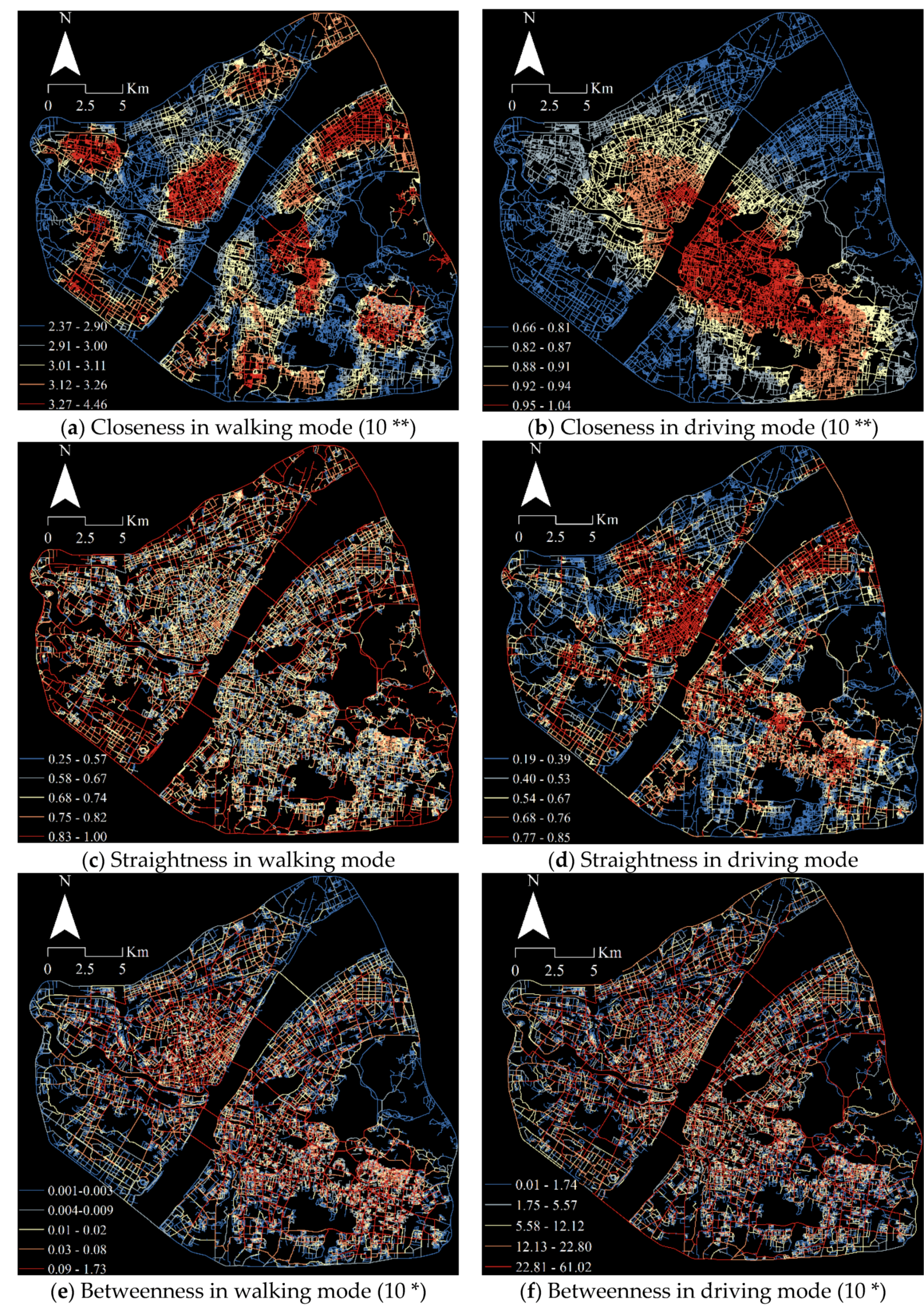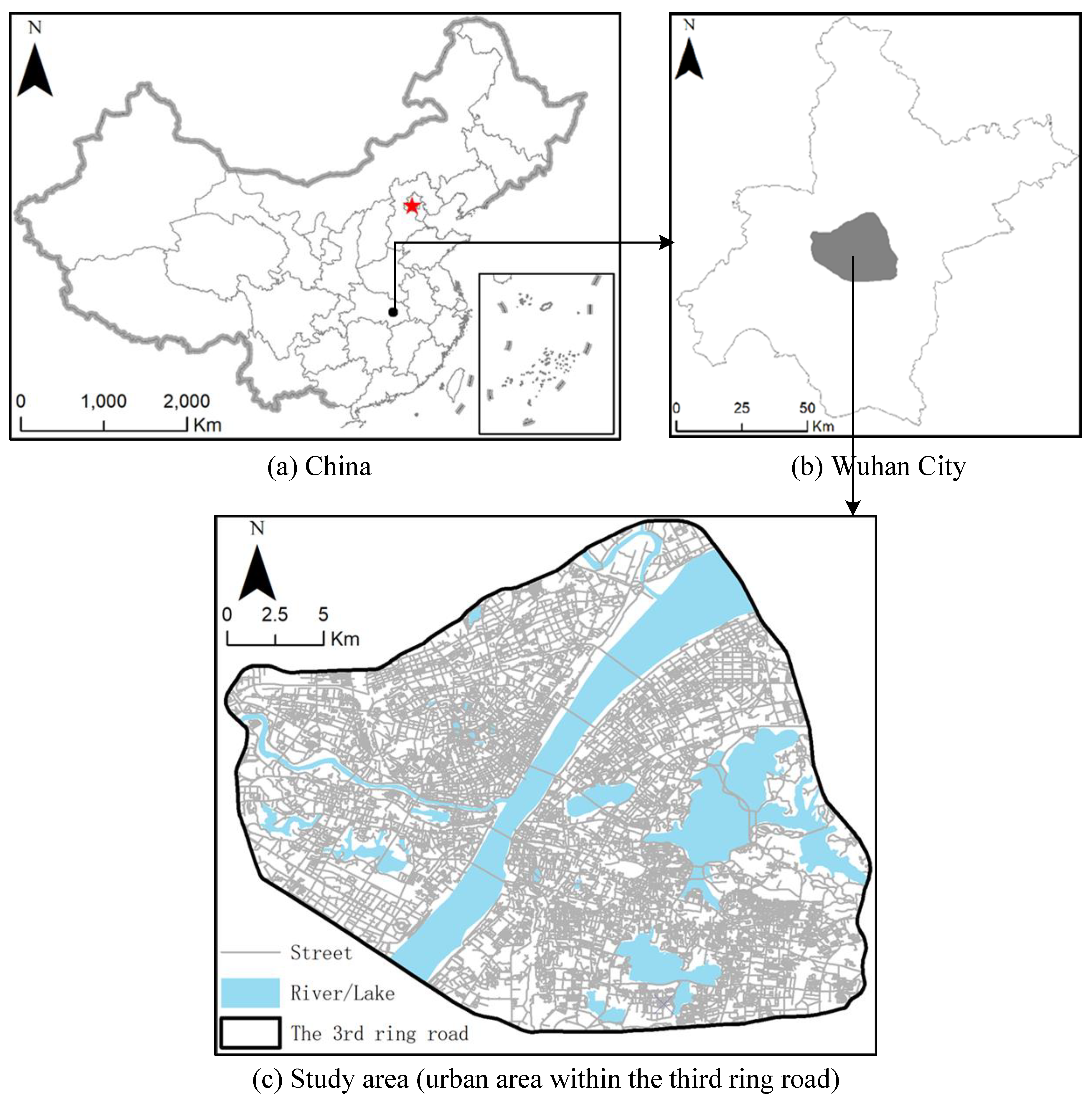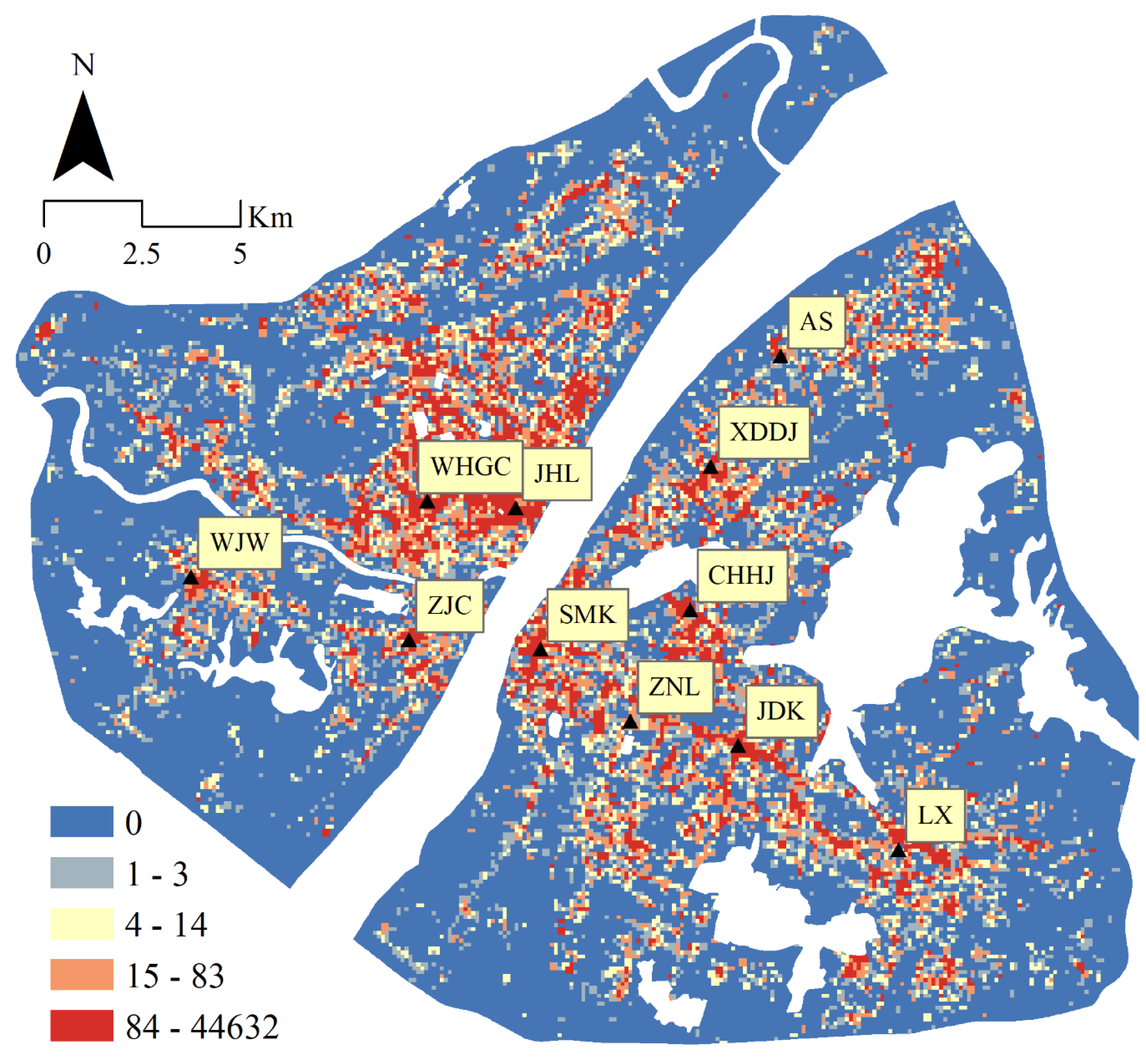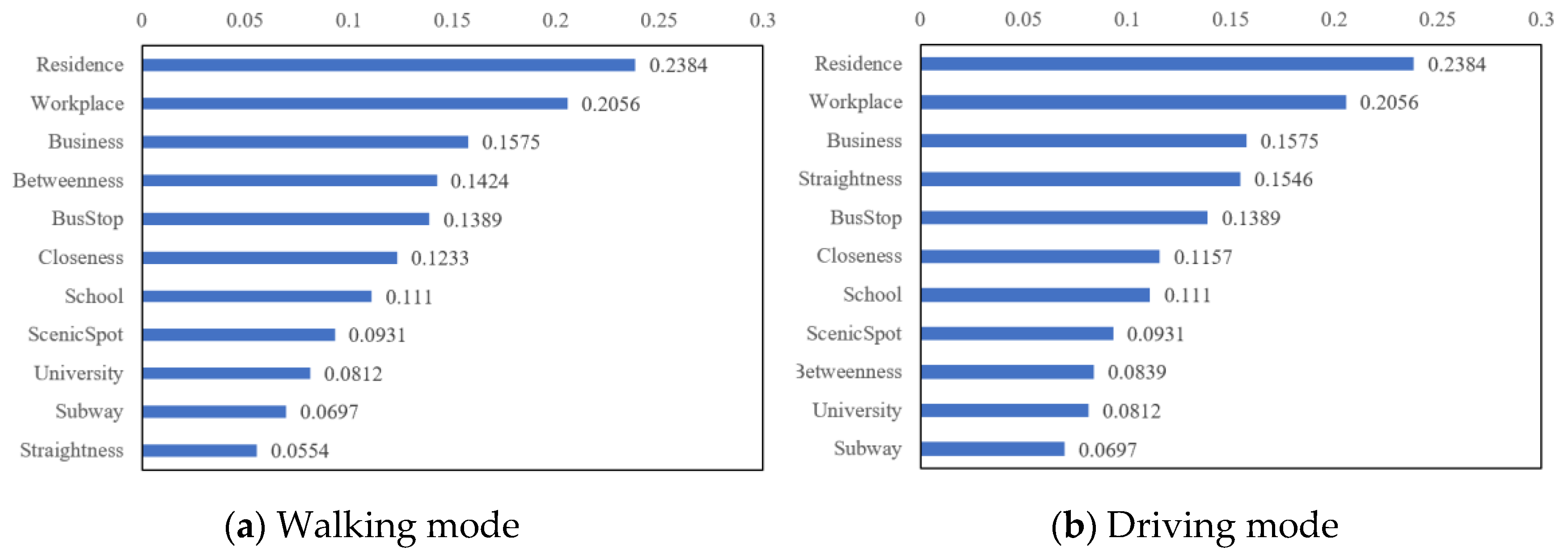Exploring the Relationship between Urban Vitality and Street Centrality Based on Social Network Review Data in Wuhan, China
Abstract
1. Introduction
1.1. Urban Vitality
1.2. Relationship between Urban Vitality and Street Centrality
2. Materials and Methods
2.1. Study Area and Data Preparation
2.1.1. Study Area
2.1.2. Social Network Review Data
2.1.3. Centrality Assessment of Street Network
2.1.4. Convert Data into One Analysis Unit by Creating A Square Mesh
2.1.5. Control Variables
2.2. Methods
2.2.1. Exploratory Spatial Coupling Analysis
2.2.2. Spatial Regression Models
2.2.3. Geographical Detector (GD) Technique
3. Results and Discussions
3.1. Geospatial Visualization of Urban Vitality and Street Centrality
3.2. Exploratory Spatial Coupling Analysis
3.3. Results of Spatial Regression Analysis and Geographical Detector
4. Conclusions
- Urban vitality demonstrated a high level of spatial agglomeration. Most regions with high vitality coincided in position with streets;
- Different street centralities had different distribution characteristics in space. Regions with high closeness in walking mode were gathered in several isolated clusters, while regions with high closeness in driving mode presented a monocentric pattern with the downtown as the center. Regions with high straightness in walking mode were dispersed in space, while regions with high straightness in driving mode were clustered along main roads. Regions with high betweenness in walking and driving modes coincided in position with main roads;
- Spatial association between urban vitality and street centrality in different travel modes was revealed. When considering street centrality in walking mode, betweenness had the most significant impact on urban vitality, followed by closeness and straightness. When considering street centrality in driving mode, however, straightness had the most significant impact, followed by closeness and betweenness.
Author Contributions
Funding
Conflicts of Interest
Appendix A

References
- Ye, Y.; Li, D.; Liu, X. How block density and typology affect urban vitality: An exploratory analysis in Shenzhen, China. Urban Geogr. 2018, 39, 631–652. [Google Scholar] [CrossRef]
- Den Hartog, H. Shanghai New Towns: Searching for Community and Identity in a Sprawling Metropolis; 010 Publishers: Rotterdam, The Netherlands, 2010. [Google Scholar]
- Chen, T.; Hui, E.C.M.; Wu, J.; Lang, W.; Li, X. Identifying urban spatial structure and urban vibrancy in highly dense cities using georeferenced social media data. Habitat Int. 2019, 89, 102005. [Google Scholar] [CrossRef]
- Findlay, A.; Sparks, L. LR Policies Adopted to Support a Healthy Retail Sector; Scottish Government Social Research: Edinburgh, UK, 2009.
- Jacobs, J. The Death and Life of Great American Cities; Random House: New York, NY, USA, 1961. [Google Scholar]
- Montgomery, J. Making a city: Urbanity, vitality and urban design. J. Urban Des. 1998, 3, 93–116. [Google Scholar] [CrossRef]
- Landry, C. Urban vitality: A new source of urban competitiveness. Archis 2000, 12, 8–13. [Google Scholar]
- Li, M.; Shen, Z.; Hao, X. Revealing the relationship between spatio-temporal distribution of population and urban function with social media data. GeoJournal 2016, 81, 919–935. [Google Scholar] [CrossRef]
- Jin, X.; Long, Y.; Sun, W.; Lu, Y.; Yang, X.; Tang, J. Evaluating cities’ vitality and identifying ghost cities in China with emerging geographical data. Cities 2017, 63, 98–109. [Google Scholar] [CrossRef]
- Wang, F.; Guldmann, J.M. Simulating urban population density with a gravity-based model. Socio-Econ. Plan. Sci. 1996, 30, 245–256. [Google Scholar] [CrossRef]
- Braun, L.M.; Malizia, E. Downtown vibrancy influences public health and safety outcomes in urban counties. J. Transp. Health 2015, 2, 540–548. [Google Scholar] [CrossRef]
- Mellander, C.; Lobo, J.; Stolarick, K.; Matheson, Z. Night-Time Light Data: A Good Proxy Measure for Economic Activity? PLoS ONE 2015, 10, e0139779. [Google Scholar] [CrossRef]
- Harvey, L. Defining and measuring employability. Qual. High. Educ. 2001, 7, 97–109. [Google Scholar] [CrossRef]
- Nicodemus, A.G. Fuzzy vibrancy: Creative placemaking as ascendant US cultural policy. Cult. Trends 2013, 22, 213–222. [Google Scholar] [CrossRef]
- Wang, T.; Wang, Y.; Zhao, X.; Fu, X. Spatial distribution pattern of the customer count and satisfaction of commercial facilities based on social network review data in Beijing, China. Comput. Environ. Urban Syst. 2018, 71, 88–97. [Google Scholar] [CrossRef]
- Zeng, C.; Song, Y.; He, Q.; Shen, F. Spatially explicit assessment on urban vitality: Case studies in Chicago and Wuhan. Sustain. Cities Soc. 2018, 40, 296–306. [Google Scholar] [CrossRef]
- Zukin, S. Naked City: The Death and Life of Authentic Urban Places; Oxford University Press: New York, NY, USA, 2010. [Google Scholar]
- Roig-Tierno, N.; Baviera-Puig, A.; Buitrago-Vera, J.; Mas-Verdu, F. The retail site location decision process using GIS and the analytical hierarchy process. Appl. Geogr. 2013, 40, 191–198. [Google Scholar] [CrossRef]
- Dawson, J.A. Retail Geography; Halsted Press: New York, NY, USA, 2013. [Google Scholar]
- Philipsen, K. How Food Became the Ferment of Urbanity. Community Architecture Website 2015. Available online: http://archplanbaltimore.blogspot.sg/2015/10/how-food-became-ferment-of-urbanity.html (accessed on 25 May 2019).
- Huang, Q.; Wong, D.W.S. Activity patterns, socioeconomic status and urban spatial structure: What can social media data tell us? Int. J. Geogr. Inf. Sci. 2016, 30, 1873–1898. [Google Scholar] [CrossRef]
- Hu, Y.; Gao, S.; Janowicz, K.; Yu, B.; Li, W.; Prasad, S. Extracting and understanding urban areas of interest using geotagged photos. Comput. Environ. Urban Syst. 2015, 54, 240–254. [Google Scholar] [CrossRef]
- Sun, Y.; Fan, H.; Li, M.; Zipf, A. Identifying the city center using human travel flows generated from location-based social networking data. Environ. Plan. B Plan. Des. 2016, 43, 480–498. [Google Scholar] [CrossRef]
- Yue, Y.; Zhuang, Y.; Yeh, A.G.O.; Xie, J.-Y.; Ma, C.-L.; Li, Q.-Q. Measurements of POI-based mixed use and their relationships with neighbourhood vibrancy. Int. J. Geogr. Inf. Sci. 2017, 31, 658–675. [Google Scholar] [CrossRef]
- Lefebvre, H. Writings on Cities; Blackwell Publishing: Oxford, UK, 1968. [Google Scholar]
- Oliveira, V. Morpho: A methodology for assessing urban form. Urban Morphol. 2013, 17, 21–33. [Google Scholar]
- Yue, H.; Zhu, X.; Ye, X.; Hu, T.; Kudva, S. Modelling the effects of street permeability on burglary in Wuhan, China. Appl. Geogr. 2018, 98, 177–183. [Google Scholar] [CrossRef]
- Rui, Y.K.; Ban, Y.F. Exploring the relationship between street centrality and land use in Stockholm. Int. J. Geogr. Inf. Sci. 2014, 28, 1425–1438. [Google Scholar] [CrossRef]
- Cui, C.; Wang, J.; Wu, Z.; Ni, J.; Qian, T. The Socio-Spatial Distribution of Leisure Venues: A Case Study of Karaoke Bars in Nanjing, China. ISPRS Int. J. Geo-Inf. 2016, 5, 150. [Google Scholar] [CrossRef]
- Kang, C.-D. Measuring the effects of street network configurations on walking in Seoul, Korea. Cities 2017, 71, 30–40. [Google Scholar] [CrossRef]
- Wang, F.; Antipova, A.; Porta, S. Street centrality and land use intensity in Baton Rouge, Louisiana. J. Transp. Geogr. 2011, 19, 285–293. [Google Scholar] [CrossRef]
- He, S.; Yu, S.; Wei, P.; Fang, C. A spatial design network analysis of street networks and the locations of leisure entertainment activities: A case study of Wuhan, China. Sustain. Cities Soc. 2019, 44, 880–887. [Google Scholar] [CrossRef]
- Lin, G.; Chen, X.; Liang, Y. The location of retail stores and street centrality in Guangzhou, China. Appl. Geogr. 2018, 100, 12–20. [Google Scholar] [CrossRef]
- Wang, F.; Chen, C.; Xiu, C.; Zhang, P. Location analysis of retail stores in Changchun, China: A street centrality perspective. Cities 2014, 41, 54–63. [Google Scholar] [CrossRef]
- Porta, S.; Crucitti, P.; Latora, V. The network analysis of urban streets: A primal approach. Environ. Plan. B Plan. Des. 2006, 33, 705–725. [Google Scholar] [CrossRef]
- Borruso, G. Network density and the delimitation of urban areas. Trans. GIS 2003, 7, 177–191. [Google Scholar] [CrossRef]
- Nes, A.V. Typology of shopping areas in Amsterdam. In Proceedings of the 5th International Symposium on Space Syntax, Delft, The Netherlands, 13–17 June 2005. [Google Scholar]
- Hansen, W. How accessibility shapes land use. J. Am. Inst. Plan. 1959, 25, 73–76. [Google Scholar] [CrossRef]
- Hillier, B. Space Is the Machine: A Configurational Theory of Architecture; Cambridge University Press: Cambridge, UK, 1996. [Google Scholar]
- Porta, S.; Strano, E.; Iacoviello, V.; Messora, R.; Latora, V.; Cardillo, A.; Wang, F.; Scellato, S. Street centrality and densities of retail and services in Bologna, Italy. Environ. Plan. B Plan. Des. 2009, 36, 450–465. [Google Scholar] [CrossRef]
- Anselin, L.; Bera, A. Spatial dependence in linear regression models with an introduction to spatial econometrics. In Handbook of Applied Economic Statistics; Ullah, A., Giles, D.E., Eds.; Marcel Dekker: New York, NY, USA, 1998; pp. 237–289. [Google Scholar]
- National Bureau of Statistics of China. Wuhan Statistical Yearbook-2016; China Statistics Press: Beijing, China, 2016. [Google Scholar]
- Jiang, B.; Claramunt, C. Topological Analysis of Urban Street Networks. Environ. Plan. B Plan. Des. 2004, 31, 151–162. [Google Scholar] [CrossRef]
- Sabidussi, G. The centrality index of a graph. Psychometrika 1966, 31, 581–603. [Google Scholar] [CrossRef] [PubMed]
- Dalton, R.C. The secret is to follow your nose: Route Path Selection and Angularity. Environ. Behav. 2003, 35, 107–131. [Google Scholar] [CrossRef]
- Freeman, L.C. A set of measures of centrality based on betweenness. Sociometry 1977, 40, 35–41. [Google Scholar] [CrossRef]
- Sevtsuk, A.; Mekonnen, M.; Kalvo, R. Urban Network Analysis: A Toolbox v1.01 for ArcGIS; Singapore University of Technology and Design: Singapore, 2013. [Google Scholar]
- Ye, Y. Urban Form Index for Quantitative Urban Morphology and Urban Design Analyses. Ph.D. Thesis, University of Hong Kong, Hong Kong, China, September 2015. [Google Scholar]
- Anselin, L. Local Indicators of Spatial Association—LISA. Geogr. Anal. 1995, 27, 93–115. [Google Scholar] [CrossRef]
- Clifford, P.; Richardson, S. Testing the association between two spatial processes. Stat. Decis. 1985, 2, 155–160. [Google Scholar]
- Wang, J.F.; Li, X.H.; Christakos, G.; Liao, Y.L.; Zhang, T.; Gu, X.; Zheng, X.Y. Geographical Detectors—Based Health Risk Assessment and its application in the neural tube defects study of the Heshun Region, China. Int. J. Geogr. Inf. Sci. 2010, 24, 107–127. [Google Scholar] [CrossRef]
- Crane, R. Cars and drivers in the new suburbs: Linking access to travel in neotraditional planning. J. Am. Plan. Assoc. 1996, 62, 51–65. [Google Scholar] [CrossRef]




| Urban Vitality | Chi-Square | Fisher’s Exact Test | |||||
|---|---|---|---|---|---|---|---|
| Any Hotspot? | |||||||
| 0 | 1 | ||||||
| Street centrality (walking mode) | Closeness | Any hotspot? | 0 | 33,713 | 549 | 667.60 | p < 0.001 |
| 1 | 9991 | 666 | |||||
| Straightness | Any hotspot? | 0 | 34,463 | 1185 | 251.07 | p < 0.001 | |
| 1 | 9241 | 30 | |||||
| Betweenness | Any hotspot? | 0 | 37,119 | 638 | 932.75 | p < 0.001 | |
| 1 | 6585 | 577 | |||||
| Street centrality (driving mode) | Closeness | Any hotspot? | 0 | 30,208 | 236 | 1339.06 | p < 0.001 |
| 1 | 13,496 | 979 | |||||
| Straightness | Any hotspot? | 0 | 30,791 | 162 | 1805.19 | p < 0.001 | |
| 1 | 12,913 | 1053 | |||||
| Betweenness | Any hotspot? | 0 | 38,225 | 742 | 724.05 | p < 0.001 | |
| 1 | 5479 | 473 | |||||
| Street Centrality (Walking Mode) | Street Centrality (Driving Mode) | |||||
|---|---|---|---|---|---|---|
| Closeness | Straightness | Betweenness | Closeness | Straightness | Betweenness | |
| Spearman | 0.2401 ** | 0.1031 * | 0.4171 *** | 0.3594 *** | 0.4124 *** | 0.2861 ** |
| Kendall’s tau-b | 0.1826 *** | 0.0826 ** | 0.3188 *** | 0.2733 *** | 0.3158 *** | 0.2163 *** |
| Variable | Model | ||
|---|---|---|---|
| OLS | SLM | SEM | |
| ρ (spatial lag coefficient) | - | 0.6891 *** (0.0045) | - |
| λ (spatial error coefficient) | - | - | 0.7289 *** (0.0046) |
| Constant | 0 (0.0037) | −0.0023 (0.0029) | −0.0033 (0.0109) |
| Closeness | 0.0474 *** (0.0039) | 0.0430 *** (0.0038) | 0.0690 *** (0.0103) |
| Straightness | 0.0433 *** (0.0047) | 0.0202 ** (0.0032) | 0.0285 * (0.0061) |
| Betweenness | 0.0514 *** (0.0041) | 0.0796 *** (0.0033) | 0.1080 *** (0.0085) |
| Gravity index of residence | 0.2646 *** (0.0044) | 0.1357 *** (0.0036) | 0.1421 *** (0.0041) |
| Gravity index of workplace | 0.1682 *** (0.0040) | 0.1083 *** (0.0032) | 0.1204 *** (0.0036) |
| Distance to the nearest business district | −0.0271 *** (0.0037) | −0.1479 *** (0.0045) | −0.1623 *** (0.0114) |
| Distance to the nearest bus stop | −0.0816 *** (0.0034) | −0.1409 *** (0.0042) | −0.1339 *** (0.0049) |
| Distance to the nearest subway station | −0.0036 ** (0.0033) | −0.0633 *** (0.0040) | −0.0622 *** (0.0089) |
| Distance to the nearest school | −0.0246 ** (0.0042) | −0.0104 (0.0034) | −0.0199 * (0.0052) |
| Distance to the nearest university | −0.0147 *** (0.0033) | −0.0427 *** (0.0041) | −0.0460 *** (0.0066) |
| Distance to the nearest scenic spot | −0.1329 *** (0.0039) | −0.0521 *** (0.0032) | −0.0935 *** (0.0059) |
| Log-likelihood | −52,482.8 | −44,812.0 | −45,008.5 |
| AIC | 104,990 | 89,650.1 | 90,041.1 |
| R2 | 0.3941 | 0.6059 | 0.6042 |
| Robust Lagrange multiplier test | - | 15,341.4445 (p-value: 0.000) | 14,948.4297 (p-value: 0.000) |
| Moran’s I of residuals | 0.3674 *** (z-score: 153.0253) | 0.0031 (z-score: 1.3278) | −0.0099 *** (z-score: −4.1226) |
| Variable | Model | ||
|---|---|---|---|
| OLS | SLM | SEM | |
| ρ (spatial lag coefficient) | - | 0.6875 *** (0.0045) | - |
| λ (spatial error coefficient) | - | - | 0.7242 *** (0.0046) |
| Constant | 0 (0.0037) | −0.0022 (0.0029) | −0.0033 (0.0107) |
| Closeness | 0.0207 *** (0.0042) | 0.0409 *** (0.0040) | 0.0525 *** (0.0065) |
| Straightness | 0.0469 *** (0.0049) | 0.0731 *** (0.0044) | 0.0869 *** (0.0094) |
| Betweenness | 0.0016 (0.0036) | 0.0200 *** (0.0052) | 0.0456 *** (0.0130) |
| Gravity index of residence | 0.2604 *** (0.0044) | 0.1349 *** (0.0036) | 0.1418 *** (0.0041) |
| Gravity index of workplace | 0.1709 *** (0.0040) | 0.1092 *** (0.0032) | 0.1227 *** (0.0037) |
| Distance to the nearest business district | −0.0181 *** (0.0040) | −0.1188 *** (0.0049) | −0.1379 *** (0.0120) |
| Distance to the nearest bus stop | −0.0755 *** (0.0034) | −0.1372 *** (0.0041) | −0.1380 *** (0.0049) |
| Distance to the nearest subway station | −0.0033 (0.0033) | −0.0634 *** (0.0040) | −0.0650 *** (0.0088) |
| Distance to the nearest school | −0.0142 *** (0.0034) | −0.0245 *** (0.0041) | −0.0211 *** (0.0052) |
| Distance to the nearest university | −0.0131 *** (0.0034) | −0.0408 *** (0.0041) | −0.0469 *** (0.0067) |
| Distance to the nearest scenic spot | −0.0472 *** (0.0033) | −0.1193 *** (0.0040) | −0.0903 *** (0.0060) |
| Log-likelihood | −52,450.1 | −44,871.4 | −45,089.1771 |
| AIC | 104,924 | 89,768.9 | 90,202.4 |
| R2 | 0.3950 | 0.6039 | 0.6030 |
| Robust Lagrange multiplier test | - | 15,157.3234 (p-value: 0.000) | 14,721.8656 (p-value: 0.000) |
| Moran’s I of residuals | 0.3660 *** (z-score: 152.4385) | 0.0033 (z-score: 1.3717) | −0.0090 *** (z-score: −3.7657) |
© 2019 by the authors. Licensee MDPI, Basel, Switzerland. This article is an open access article distributed under the terms and conditions of the Creative Commons Attribution (CC BY) license (http://creativecommons.org/licenses/by/4.0/).
Share and Cite
Yue, H.; Zhu, X. Exploring the Relationship between Urban Vitality and Street Centrality Based on Social Network Review Data in Wuhan, China. Sustainability 2019, 11, 4356. https://doi.org/10.3390/su11164356
Yue H, Zhu X. Exploring the Relationship between Urban Vitality and Street Centrality Based on Social Network Review Data in Wuhan, China. Sustainability. 2019; 11(16):4356. https://doi.org/10.3390/su11164356
Chicago/Turabian StyleYue, Han, and Xinyan Zhu. 2019. "Exploring the Relationship between Urban Vitality and Street Centrality Based on Social Network Review Data in Wuhan, China" Sustainability 11, no. 16: 4356. https://doi.org/10.3390/su11164356
APA StyleYue, H., & Zhu, X. (2019). Exploring the Relationship between Urban Vitality and Street Centrality Based on Social Network Review Data in Wuhan, China. Sustainability, 11(16), 4356. https://doi.org/10.3390/su11164356





